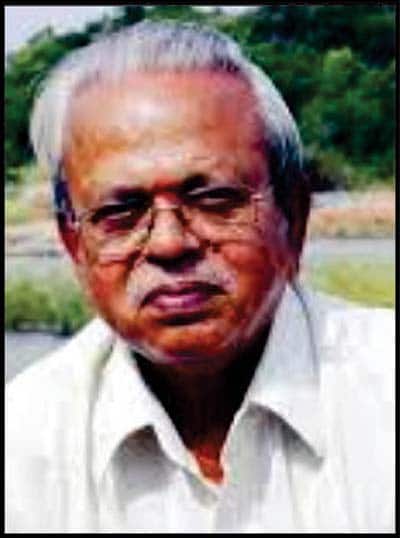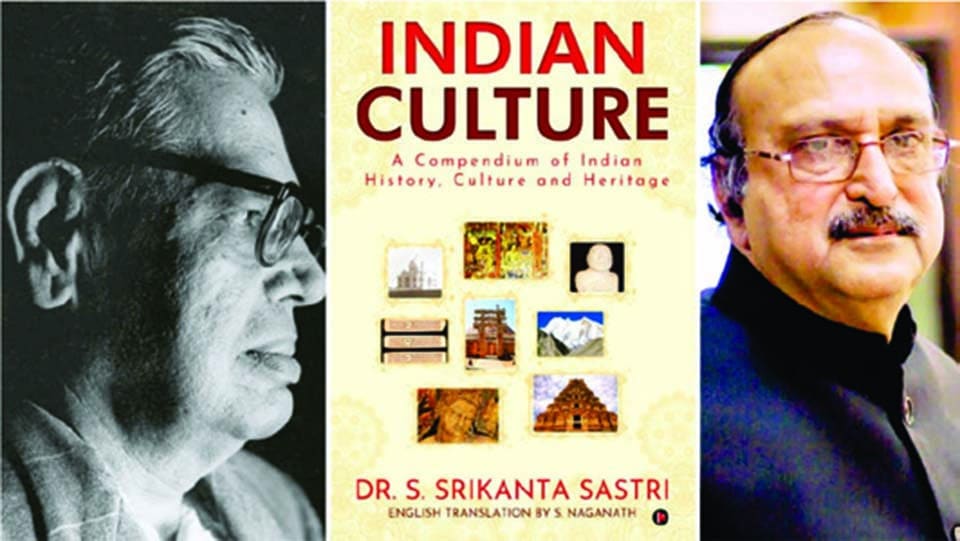Title: Indian Culture
Kannada Original: Dr. S. Srikanta Sastri
English translation: Prof. S. Naganath
Year: 2021
Pages: 669
Price: Rs. 800
Publisher: Notion Press Media Pvt. Ltd., Chennai
Originally written in Kannada by renowned scholar and historian, Dr. S. Srikanta Sastri (1904-1974) under the title “Bharathiya Samskruthi” in 1954, this compendium of Indian history, culture and heritage has seen six reprints since then and now it has been translated into English by his son, Prof. S. Naganath, retired Professor of English of the Bangalore University, to cater to a wider section of non-Kannada knowing readers.
Dr. Srikanta Sastri was Professor of History and Indology at the Maharaja’s College, Mysuru, from 1925 to 1960. Besides his academic work, his significant contribution includes five books in English and seven in Kannada. Proficient in as many as 15 languages, the Professor has written 116 research articles in English and 122 in Kannada, a collection of some of them has also been published under the title “Samshodana Lekhanagalu,” besides eight in Telugu, one each in Sanskrit and Hindi.
The fact that “Bharathiya Samskruthi” has seen as many as six reprints between 1954 and 2015 and now in English highlights the significance of this masterly work, its popularity and usefulness. Although it was written during the Second World War when India was under British rule, it continues to be a major reference work on Indian culture.
“Bharathiya Samskruthi” covers a wide range of subjects like civilisation and culture, physical features of the Indian sub-continent, the early man in India, languages, the proto-Indic culture, Vedic culture, Vedic scholarship, history and mythology, different Indian philosophical schools, Vedic society, the economy in the Vedic age, political institutions, literature, arts and science, greater India, and a bird’s eye view of Indian culture. About 90 illustrations and tables support the topics covered in the 670-page English version. It also includes 258 Sanskrit quotations which have been translated into English. A reader will find the stupendous task of the author in covering such a vast area in one volume and also the challenging task faced by the translator.

In his introductory remarks, Prof. Naganath sums up, “the reader just has to take a good look at the bibliography section to realise the amount of research work and in-depth study that has gone into the writing of this book (the bibliography lists nearly 500 titles). Dr. Srikanta Sastri’s genius helped to assemble an intricate mosaic of Indian culture with these numerous bits of information. Dr. Srikanta Sastri finally projects a harmonious meaningful and aesthetically beautiful collage of multi-faceted Indian culture in one canvas.”
In his foreword in 1954, poet laureate K.V. Puttappa (Kuvempu) hails it as a “profound research work.”
When one goes through the 600 and odd pages, one will understand the vast knowledge Dr. Srikanta Sastri had acquired. He provides answers to some fundamental questions on Indian culture and offers us interesting bits of information on different aspects of Indian culture, history and heritage. To quote a few: No Indus site has been discovered in South India; one can trace many of the lifestyle practices of modern-day Indians to the Indian valley civilisation; one glaring example of Hindu tolerance is the survival of Jainism in India; amongst the Army Generals of Vishnuvardhana (the Hoysala king) the most famous ones were Garudas who were all Jaina believers; we learn from “Shankara Bashya” that there was an older text on the science of Yoga even before Patanjali’s text; the true meaning of Yoga is re-joining of soul (Atma) with God (Eshwara); worship of Shakti is an age-old religious practice and it can be traced to the Vedic age; the Shakta cult was widespread from Afghanistan in north-western region to Assam in eastern region of India; Surya temples are very rare in India; the cult of Sun God worship led to a study of astrology in India; the Brahmavadin girls underwent Upanayanam ceremony at the age of eight and they were eligible to study in a Gurukula; Kamasutra states that Ganikas must be well-versed in 64 Kalas; many of the courtesans were custodians of cultures and were educated and talented; no ancient Smriti mentions compulsory shaving of the head of a widow; and many more such revealing statements.
One particular mention which interested me more was about the Maori language. Maoris were the original settlers in New Zealand. Referring to these indigenous Polynesian people, the author says, “In the Maori language, we find these words ‘Matariki’ (Kritika star), ‘Matrukeru’ (7 Mother Goddesses), ‘Raka’ (Poornima – full moon day) and “Kuhu” (Amavasya – new moon day) which are Sanskrit derivatives and these people claim that they are from the land of Ganges river. Their language has a close affinity to Sanskrit.”
Here I may add that after finding how Maori culture and language is similar to ours during one of my visits to New Zealand about a decade ago, I had written an article in a magazine there with the caption, “Are we brothers” highlighting how close similarities are there between their culture and language with ours, particularly we Kannadigas. I was happy I could find support for my observation in this work, the magnum-opus of Dr. Srikanta Sastri.
Overall, “Indian Culture” serves as a useful work, besides being a reference work for all those interested in Indian culture and its aspects. Prof. Naganath has enriched its value by providing explanation or clarification wherever necessary, mentioning clearly that it is only an editor’s note. He deserves to be complimented for translating his father’s work to reach a wider audience.
By Gouri Satya, Sr. Journalist








Recent Comments